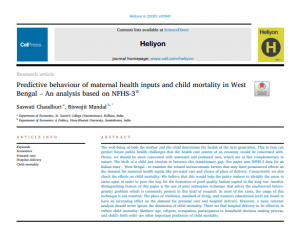
View Resource
The well-being of both the mother and the child determines the health of the next generation. This in turn can predict future public health challenges that the health care system of an economy would be concerned with. Hence, we should be more concerned with antenatal and postnatal care, which are in fact complementary in nature.
The birth of a child just coexists in between this transitionary gap. Our paper uses NFHS-3 data for an Indian state – West Bengal – to examine the related socioeconomic factors that may have pronounced effects on the demand for maternal health inputs like pre-natal care and choice of place of delivery. Concurrently we also check the effects on child mortality. We believe that this would help the policy makers to identify the areas to stress upon in order to pave the way for the formation of good quality human capital in the long run.
Another distinguishing feature of this paper is the use of joint estimation technique that solves the unobserved heterogeneity problem which is commonly present in this kind of research. In most of the cases, the usage of this technique is not resorted. The place of residence, standard of living, and women’s educational level are found to have an increasing effect on the demand for prenatal care and hospital delivery.
However, a more relevant analysis should never ignore the dimension of child mortality. There we find hospital delivery to be effective to reduce child mortality. Mothers’ age, religion, occupation, participation in household decision making process, and child’s birth order are other important predictors of child mortality.